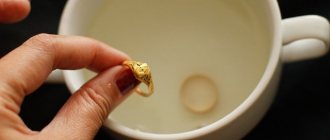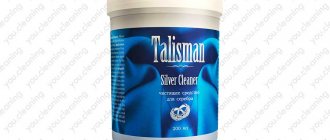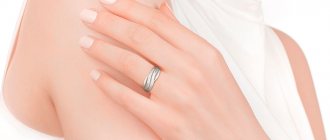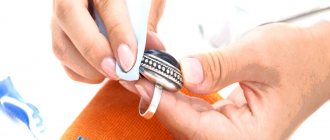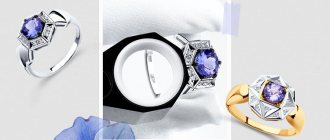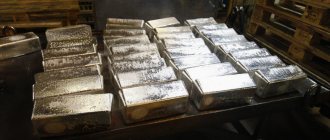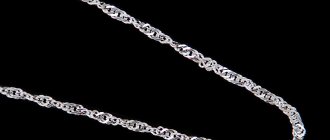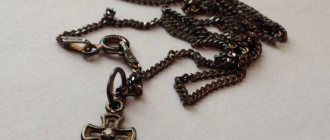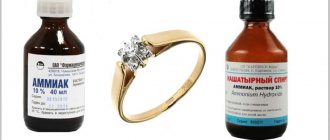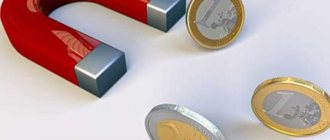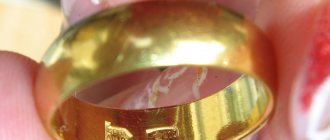How to get rid of scratches on silver
Pastes
I would call this method the most labor-intensive and time-consuming, but since it still helps get rid of minor scratches and defects, it is worth mentioning. The problem can be solved by vigorous polishing with a soft cloth and a silver cleaner. This can be green GOI paste or regular chalk soaked in water. Through prolonged grinding you will achieve a level surface. But if the damage is severe, this method will not help.
Fine skin
On some products, deep scratches can be removed using the finest sandpaper (“zero”). After this, the surface must be thoroughly polished using GOI paste (for silver, No. 2 is better) and soft cloth or felt. The method, of course, requires increased accuracy and tenderness, since if you overdo it with pressure, the thing can be completely ruined.
Nail files
To eliminate minor defects, nail files with a soft coating are suitable. These are exactly the ones used to polish the nail plate. If the scratch is in an “inconvenient” place, you will have to look for a file with a narrow end to get to the flaw.
Polishing paper
If you can purchase special polishing paper, you can use it to remove scratches from a silver item. Sheets of paper have different degrees of abrasiveness, so moving from rougher to softer, there is a chance to smooth out the damaged area to perfection. The advantage of this paper is that it is convenient to fold and repair even products with small parts in inconvenient places.
Silicone rings
This option also requires the purchase of special things, namely round silicone nozzles. Just like with paper, they come in different forms - from the so-called “sandpaper” to soft polishing ones. The size of silicone circles can be selected according to the product.
To work, you will also need a grinding machine or any of its home equivalents - for example, a bead expander. A silicone ring is placed on the rotating rod of the machine, first for rougher processing and then for more delicate polishing. Such attachments have teeth, so when replacing it is important that they point in the same direction as the teeth of the previous ring.
What you need to remember to avoid scratches on silver
- Keep silver items away from items with sharp edges. Silver is a soft metal, so it is very easy to scratch.
- To avoid mechanical damage to the surface, cleaning items made of white metal must also be done separately from other items.
- Clean items regularly using special or improvised products.
- Do not get carried away with professional polishing too often - this will thin the metal layer.
- Do not use powdered soda to clean silver - this abrasive leaves numerous small scratches.
- Polish silver only with a soft cloth (flannel, felt).
- If you use cleaning sponges, you can polish only with the soft side, but in no case with the rough side.
- Remove jewelry made from precious metals before swimming in the sea or pool.
Depending on the nature and degree of damage, the design of the item itself, as well as financial and other possibilities (attachments and polishing paper cost money), you can choose the best silver restoration option for yourself. But finally, one more piece of advice - start with the gentlest method, if it doesn’t help, move on to more radical ones.
Source
Methods for cleaning silver
Silver can be cleaned and polished at any jewelry workshop.
Polishing the surface of a silver ring in a jewelry workshop
However, if you want to do it yourself, cleaning silver at home is also not difficult. Hardware or jewelry stores sell special products for cleaning silver items, but they are quite expensive. As a home alternative, there are proven “recipes from grandmothers” that use non-aggressive alkaline and acidic substances that any housewife has on hand.
Ammonia
One of the most common ways to clean silver from blackness is ammonia solution . The solution is prepared at the rate of 1 tsp. 10% ammonia per 1 glass (250 ml) of water. For greater effect, add a few drops of hydrogen peroxide and liquid soap . Silver items are soaked in the solution for 10-20 minutes (depending on the degree of contamination), then washed with water and rubbed with a soft velvety cloth.
Ammonia should not be used to clean silver items containing pearls, as the pearls may lose their shine and change color.
Silver that has not darkened much does not need to be soaked in the solution for a long time. Simply wipe it with a woolen cloth moistened with ammonia.
It is not recommended to clean silver jewelry with pearls with ammonia.
Soda, salt, citric acid
Powdered products such as baking soda, salt, citric acid are used only in dissolved form for cleaning. Silver is a soft metal, so abrasive powders can ruin the shiny, smooth surface with small scratches.
To clean silver with soda , it needs to be diluted in water (2 tablespoons per 500 ml of water). The solution is brought to a boil and a piece of food foil is lowered into it along with the silver. Silver items will shine like new in just a few minutes. Also, using foil, you can use potato broth to soak silver for a short time.
Silver needs to sit in a cold soda solution for longer – 15-30 minutes. If you use salt (the solution is prepared in the same proportions), then the silver items are left in it for several hours (2-3 hours). To speed up the cleaning time in a saline solution, you need to bring it to a boil and boil the silver in it for 15-20 minutes.
If your silver items are heavily soiled, you can use baking soda and salt for the cleaning solution, adding liquid dishwashing detergent (1 tbsp per 1 liter of water). The silver is boiled in it for 20-30 minutes over low heat, observing its external condition.
To prepare a cleaning solution with citric acid, take 100 g of the substance per 500 ml of water. It is better to boil silver items in it in an enamel bowl in a water bath (15-30 minutes), and to add more shine, it is recommended to string the silver onto a small piece of copper wire or simply put it in the solution.
Vinegar
Regular vinegar (9%) will help you quickly clean silver, get rid of dull dull coating and small black spots. You need to heat it up, moisten a soft cloth with warm vinegar and wipe the silver items with it. You can also simply put them in warm vinegar and keep them in it for 15-20 minutes.
Do not consider this an advertisement, but many people believe that using Coca-Cola to clean silver is effective. It recommends soaking the products for a short time or boiling them for 2-3 minutes.
Mechanical method
Mechanical cleaning uses the entire household arsenal of “dental products”: brushes, pastes, powders. This method is quite radical (frequent mechanical cleaning leads to abrasion of the metal), so it is not recommended for products with a fine pattern. It is more suitable in cases where you need to clean silver with stones or pearls, so as not to expose them to soaking or boiling in acidic and alkaline solutions. Contaminants on silver are carefully scrubbed off using a brush smeared with a small amount of toothpaste or dipped in a solution of tooth powder. To prepare the solution, take 500 ml of water, 2 tbsp. l. tooth powder and 2 tbsp. l. ammonia.
Mechanical cleaning of a silver ring using a toothbrush
After soaking, boiling or mechanical cleaning, silver items must be rinsed with water and polished - rubbed with a soft fleecy cloth.
You can additionally polish silver rings or bracelets (solid metal surfaces) using a regular office eraser.
It is recommended to store silver items that you do not wear constantly in “individual packaging” of food foil in a dry place.
How to polish silver: 3 effective ways
Greetings, dear friends!
Silver is a valuable 925 sterling metal, which is actively used for the manufacture of luxury jewelry and expensive sets of kitchen utensils. It is known that silver ions have disinfecting properties , and the use of silver utensils has a positive effect on health.
Despite all its grace and beauty, this metal, unfortunately, has the tendency to quickly fade. Over time, silver loses its shine, acquires a dark tint, and also becomes scratched. In order for this precious alloy to continue to delight its owner with its brilliance for a long time, it is important to properly care for it. In today's article, we will take a closer look at the most effective ways to polish silver at home without damaging your valuable treasure. Before moving on to considering this issue, it is interesting to know why does silver darken in general?
How to clean silver at home
If your favorite chain, pendant or earrings have darkened, don’t be upset. We will give you all the secrets of how to clean silver at home, and you choose the most accessible method for you and get to work – returning the metal its attractive beauty and radiance!
But first, one warning! Before using any method, experiment with a piece of silver that you don't mind too much. And only then move on to expensive or antique jewelry.
Ammonia
This is a great way to brighten your silver item safely and quickly. So, how to clean a silver chain at home using an ordinary product lying around in your medicine cabinet?
Take a ceramic bowl and measure out one part of ammonia, dilute with nine parts of clean cold water. Place the decorations in the solution so that they sink and leave for half an hour. After this, be sure to wipe the item dry - and enjoy its shine!
Hydrogen peroxide
Another substance that perfectly dissolves dark plaque without damaging the silver surface. Cleaning silver at home with this product is a home “life hack” that was also used by our mothers and grandmothers.
Take a bowl and mix water and peroxide, about one to eight. Add a couple of drops of ammonia. Rinse your darkened items with warm water and soap or tooth powder to degrease and remove dirt. Immerse in the solution and leave for a couple of hours. Polish lightly with a soft sponge or brush. Rinse and dry with a towel. Ready!
Salt
Salt is a fairly effective way to clean silver at home. True, it is not suitable for jewelry with gold or stones, as it can ruin them. Under no circumstances rub the metal with grains of salt, you will scratch it!
Prepare a measure of table salt, about half a glass for three glasses of water. Place the mixture on the fire and let it boil. Immerse your silver in boiling water and turn off the heat. After an hour, take it out, rub it with a soft cloth, rinse and dry.
Soda
A simple method on how to clean silver at home “cheap and cheerful”. If your kitchen appliances or favorite knick-knacks are looking black and dull, try your usual baking soda. However, if there is a stone on your bracelets or ring, the method will not work.
Take six tablespoons of baking soda and add half a liter of water. Bring the baking soda solution to a boil, turn off the heat and carefully plunge the trinkets directly into the boiling water. Leave it like that for an hour and a half, then carefully remove it and lightly rub it with a soft toothbrush or cloth, polishing the metal. Enjoy the shine!
Foil
Photo: https://pixabay.com/illustrations/photography-silver-985375/
An excellent material at hand is foil, which will always come to the rescue if you need to add shine and beauty to silver items. Here's a simple recipe: we need regular food foil and a little soda.
There is no magic: just aluminum (from which the foil is made) enters into a special chemical reaction with soda and releases substances that dissolve plaque on silver. At the same time, the precious metal does not suffer, but acquires its original shine and a beautiful light shade!
So, take a piece of foil about 10 by 10 cm and tear it into small pieces or cut it with scissors. Place this scattering in a deep bowl or cup. Pour 2 tsp of soda, now put your silver in the same container and pour boiling water over it. The reaction will begin, foam will appear - that means things are going well!
After 15 minutes, take the items out, rinse them and scrub them a little with a sponge. You won't recognize them!
Lemon acid
Citric acid is a good way to carefully clean products made from this metal and restore them to their former beauty. The procedure is very simple: dissolve a couple of tablespoons in a glass of water and hold your silver item there. If this is not effective, you can rub the surface directly with lemon, polishing the metal. This folk method helps to add shine and lighten the item.
Toothpaste
Another excellent and affordable method. You can use either tooth powder or any paste. Basic advice: the paste should not be bleaching; such products are abrasive, very active and can scratch the metal.
Take a little paste and coat the metal thickly, leave it like that for an hour or two. Then carefully, gently rub with a brush, but do not overdo it. Rinse with water, wipe dry - voila, the item is as good as new!
Chalk
Chalk, like tooth powder, effectively dissolves blackness and plaque from silver, but it should be used very carefully - do not rub too much so as not to scratch the surface. It’s worth making a solution of chalk and water to get a paste. Place jewelry in it and leave for a couple of hours, and then rub.
For greater effect, you can add a little citric or acetic acid to the chalk. After the procedure, rinse items and dry them.
Coca Cola
The drink we are all familiar with can eat away scale, limescale and blackness on metals. At least that's what folk craftsmen say. Pour in the silver and wait a couple of hours. Then rub a little, polishing, you can wash with toothpaste. Dry and rejoice, your jewelry will shine like new! The main thing is not to overexpose it, as the product is very aggressive.
Vinegar
Regular table vinegar is simply irreplaceable in the household. They can be used to gently and effectively clean your favorite silver trinkets. Make a solution of approximately one to five with water and leave the silver for a couple of hours. Rub the item with a soft cloth to polish and remove any remaining dissolved plaque, rinse with running water and blot with napkins. Everything is ready, it's that simple!
Special means
In stores and on the Internet you can easily find many products for removing blackness and tarnish from jewelry.
They are usually available in liquid form and have different compositions. Is it worth using such liquids? On the one hand, the use of purchased products is safe; such a product will not spoil the metal or scratch it.
On the other hand, read reviews and check the manufacturer: you can buy the most common mixture of ammonia and alcohol for a lot of money and not even know about it. But if you are afraid of folk remedies and trust only store-bought products, then feel free to try.
Why does silver lose color?
From a scientific point of view, the gradual darkening and oxidation of silver can be explained quite simply - contact with sulfur-containing compounds. In everyday life there are many opportunities for such contact - sulfur is contained in many cleaning substances and rubber gloves. In addition, silver darkens as a result of contact with human skin due to the release of sulfates - sulfuric acid salts. Thus, it is almost impossible to protect silver from gradual oxidation and darkening, which means it is very important to periodically polish silver, and today we will figure out how to do this with our own hands. So
Polishing silver with a special polish
Store-bought polish effectively removes plaque, helping to polish silver to its original shine.
The first thing to start with is choosing the type of polish you need. The fact is that it is produced in three variations:
- in liquid (Talisman - cost about 100 rubles);
- in the form of a cream (Autosol Silver Polish - cost 200-250 rubles);
- in the form of a spray (Emulsio - cost about 300 rubles);
The former is suitable for regular silver processing, while the latter is suitable for items that are too tarnished and large in size. A spray is similar to a liquid.
Having selected the desired polish, apply it to a soft towel and polish the silver. Leave the product for 2-3 minutes.
After time has passed, carefully polish the surface of the product again with a clean towel, paying special attention to areas that are too dark from plaque. Using a soft sponge, rinse off the polish with warm running water, carefully removing stains and particles of the product.
Finally, you need to completely dry the silver item by wiping it dry with a soft microfiber towel. This should be done immediately after polishing to avoid the formation of water stains. All that remains is a test polish and the product will shine like the day it was purchased!
Polishing silver with a mild detergent
The detergent helps give silver items a shine. To do this you should:
• pour water into the container so that the silver item is completely immersed in it; • then add detergent and stir until completely dissolved; • items should not be kept in the solution for too long; after a couple of minutes, you can begin to clean the silver using a sponge; • having taken the silver out of the container in which the cleaning was carried out, it must be rinsed under warm running water; • using a soft cloth, carefully wipe the silver item.
Polishing with baking soda, vinegar and aluminum foil
No less effective way. To do this, you need to prepare a deep and capacious bowl. Cover all inner walls of the container with foil. At the same time, the foil should fit as tightly as possible to the bowl, covering every centimeter of the walls of the dish.
To boil water. The amount of liquid depends on the size of the silver item - it must be completely covered with water.
Add a tablespoon of soda, the same amount of salt and 200 ml of white vinegar to the water. If the product is large, you should double the number of components.
Mix everything thoroughly. Each grain of sand must completely dissolve in water - this is very important!
After boiling completely, add more water and mix everything thoroughly again. Using tweezers, lower the products into the solution for 2-3 minutes.
After the silver has been in the liquid for the required time, remove it and wrap it in a soft towel. Once the items have cooled down, you can begin polishing.
Polish the silver with a soft sponge or cloth, paying special attention to stubborn plaque.
A few more ways to polish silver
You can polish silver to its original shine using such simple means as:
Alkazeltzer. By dissolving this effervescent product designed to improve digestion in a cup, you can get a wonderful carbonated solution, after polishing it the silver will sparkle like a New Year's toy!
Ammonia. Mix 100 ml of this component with 200 ml of warm water and dip the product into the resulting solution. After lying in such a liquid for 10 minutes, the dirt and plaque deposited on the silver will dissolve to the last speck. All that remains is to wash, dry and polish the silver with a special cloth.
Handy ways to clean silver
When you don’t have time to tinker with special products, you can use those that are always at hand:
1. Spray the silver with window cleaner, then rinse it and wipe it with a dry cloth. 2. You can rub the silver item with toothpaste for a while; the bleaching agent in the paste will help give the silver shine. 3. Mix half a cup of ammonia with a cup of water, and immerse the silver in the resulting mixture for a while. Next, rinse the metal in warm water and wipe dry with a soft cloth.
Tips and tricks
The rapid loss of shine of silver is affected by ordinary air. If you have silver cutlery, it is recommended to store them in chests of drawers, and jewelry in boxes and special cases.
As for silverware, it is not recommended to wash it in the dishwasher, because... The “dishwasher” performs a fairly aggressive wash. To keep silver dishes in their original form longer, it is better to wash them by hand , using a sponge and a mild detergent, and then dry thoroughly.
If you regularly wear silver jewelry, it will darken much more slowly.
You should get a special polishing cloth , which can be found in any jewelry store. It allows you to carefully and effectively polish silver, be it a miniature ring or a massive decorative dish.
It is important to protect silver items from contact with food and chemicals with a high acid content. It can discolor precious metal. In this case, even if you polish the silver, you will not be able to return it to its original shine.
If you often go to the pool, then it is better to remove silver items while swimming - chlorine has a negative effect on silver, destroying it.
You also need to be careful not to forget silver items in the bathroom - due to increased humidity, silver will quickly lose its shine and become covered with plaque.
